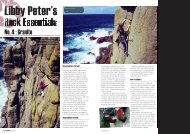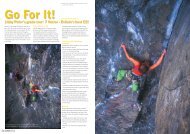Create successful ePaper yourself
Turn your PDF publications into a flip-book with our unique Google optimized e-Paper software.
Where to find dolerite ............................<br />
We don’t have tons of dolerite in this<br />
country but the chunks we do climb on<br />
give memorable excursions. If you’ve<br />
climbed on Dinas Mot in the Llanberis Pass<br />
you may have been struck by the dramatic<br />
switch from pale smooth rhyolite on the<br />
central <strong>No</strong>se, which is flanked above and on<br />
its wings by dark rough dolerite. Tremadog<br />
and its outliers are the other classic dolerite<br />
crags that we all know but it’s often hard to<br />
believe that it’s the same rock type as you<br />
slip helplessly from one polished to hold to<br />
the next.<br />
Central Scotland has a scattering of<br />
smaller but significant dolerite crags and<br />
boulders like Dumbarton rock and<br />
Auchinstary quarry near Glasgow and up on<br />
Arthur’s seat it can be seen but not touched<br />
mingled with basalt in impressive<br />
surroundings on Salisbury crags.<br />
Perhaps the most famous chunks of<br />
dolerite we have, not that we climb on them<br />
of course, are the great ‘bluestones’ that form<br />
part of the Stonehenge circle that originated<br />
in the Preseli hills in Pembrokeshire.<br />
How to climb dolerite ............................<br />
In many cases dolerite has a delicious rough<br />
texture that makes for excellent friction, an<br />
attribute that proves essential to see you<br />
safely through the frequent technical moves<br />
you encounter (and if you’re confused by this<br />
term ‘technical move’ well really it’s a catch<br />
all for anything that’s not blindingly obvious).<br />
<strong>Dolerite</strong> moves typically require creative<br />
thinking coupled with precise and confident<br />
footwork. On first arrival the move ahead can<br />
be completely baffling. Luckily, more often<br />
than not, once the initial panic subsides you<br />
realise you’re standing in balance on a steep<br />
slab so have plenty of time to think about<br />
what to do next. This of course is a double<br />
edged sword; if you can stand in balance<br />
working out the next sequence of moves, it<br />
also means there’s no sense of urgency so if<br />
you don’t like the look of what lies ahead it’s<br />
very hard to get started again. In other words,<br />
you can quite simply grind to a halt.<br />
Vector Buttress typifi es dolerite constructions<br />
– slabs, overhangs, fangs blocks and headwalls,<br />
interspersed with tree fi lled gullies.<br />
All photography: Mike Robertson<br />
<strong>No</strong>. 7 : <strong>Dolerite</strong><br />
Lou Neill making use of bridge to rest while<br />
contemplating the complex ropework required<br />
on Weaver (E2 5c), Bwlch y Moch, Tremadog.<br />
<strong>Dolerite</strong>’s smooth slabs, crinkly texture and<br />
lovely cracks. Lou Neill having reached the<br />
cheeky junction of Vector, Diadic and Weaver.<br />
So then, of course, it’s a case of being<br />
brave enough to set off on the sequence of<br />
moves you’ve decided on. <strong>Dolerite</strong> sequences<br />
do require commitment; falter part way<br />
through and you find yourself in a precarious<br />
and terrifying no-man’s land of can’t go<br />
forward, can’t go back. Time and again you<br />
have to remind yourself that you’re on a slab<br />
and should be in balance and therefore don’t<br />
need the huge handhold you crave.<br />
Easier said than done, but the upside of<br />
this psyche up and commitment is that<br />
once you’ve successfully completed a<br />
tricky section of climbing there’s a huge<br />
sense of satisfaction.<br />
Finger crack heaven<br />
Cams can go in upside down<br />
– you don’t often get this view.<br />
Best loved dolerite crags and routes<br />
........................................................<br />
Dinas Mot dolerite is the best of any we have. If dry conditions prevail rather than follow the<br />
hoards onto the <strong>No</strong>se visit the East Wing and look up Gollum (HVS 5b), or make the journey<br />
to the West Wing where you’ll find the excellent Plexus (E1 5b) and Ten Degrees <strong>No</strong>rth (E2 5c).<br />
Down the road at Tremadog the main crags hardly need any introduction and there are<br />
stars (and queues) in plenty, so when it’s mobbed at Eric’s nip along to Two Tier Buttress and<br />
seek out Stromboli (HVS 5a) or Helsinki Wall (E1 5b), the setting is peaceful and the friction on<br />
that buttress immaculate. Schedule in a visit to Craig y Castell (above Tremadog village itself)<br />
and treat yourself to Creagh Dhu Wall (HS), an all time classic or drive two minutes round the<br />
corner to Craig y Gesail where a whole cluster of VS gems like Touch and Go await and you’ll<br />
more likely than not have the crag to yourself.<br />
22 08|09<br />
climber.co.uk 08|09 23
One Step in The Clouds (VS 4c) – perhaps<br />
these moves are where it got it’s name!<br />
Meillee Rafe tiptoeing her way delicately...<br />
...to be rewarded by a perfect incut fl ake!<br />
Other sections of dolerite cliff are blocky<br />
and the climbs weave their way cunningly<br />
beneath, between and even sometimes over<br />
the overhangs the blocks create. On these<br />
routes you need to expect the unexpected; be<br />
happy to make blind reaches and now and<br />
again pull hard.<br />
How to get gear in dolerite<br />
............................<br />
Once you get your eye in you find the most<br />
perfect nut placements in the world on<br />
dolerite; tapered rough cracks that were surely<br />
designed with this particular job in mind.<br />
Quite often the exact size isn’t crucial; you just<br />
aim vaguely for the right width and say ‘yeah<br />
that’ll do’ without having to fiddle away.<br />
Cams are also effective on this high<br />
friction rock, which has plenty of parallel<br />
sided cracks but don’t relax too much as<br />
there is also a tendency for the rock type to<br />
create shallow seams that defy all attempts<br />
to seat a nut in them.<br />
How is dolerite formed? ............................<br />
<strong>Dolerite</strong> is an igneous rock type, similar in<br />
origin to rhyolite but with a composition<br />
closer to basalt as it contains a higher<br />
proportion of iron and magnesium, giving it a<br />
darker colouring. It typically forms slabs and<br />
blocks and the varying crystal size and exact<br />
chemical make-up determines its roughness.<br />
<strong>Dolerite</strong> features and hazards<br />
............................<br />
The blocky nature of some dolerite cliffs is a<br />
worrying feature of its construction. Many of<br />
the blocks are inherently loose, even the big<br />
ones. It’s still possible, for example, to walk<br />
across the worn holds of the crux of a once<br />
popular VS called Fandango, which now lies<br />
on the approach path to Pant Ifan at<br />
Tremadog. Equally horrifying is the everwidening<br />
roof crack of Barbarian on the same<br />
crag. Always be mindful that some cliffs are<br />
inherently unstable.<br />
Trees provide quick and convenient belays<br />
but often cling to their rocky perches<br />
tenuously – treat them with love and respect<br />
or they won’t be there for much longer.<br />
A special mention goes to the translucent<br />
slugs at Tremadog after rain – I’m sure they<br />
have a proper name and important role to<br />
play in the ecology of the nature reserve<br />
but that doesn’t make them any more<br />
attractive when they’re occupying the same<br />
handhold as you.<br />
Wires don’t get much<br />
more ‘sinker’- than this!<br />
<strong>Libby</strong> has been climbing for over 20<br />
years, she is a qualified Mountaineering<br />
Instructor and British Mountain Guide and<br />
is the author of Rock Climbing – Essential<br />
Skills and Techniques published by MLTUK<br />
and recently produced Get Out On Rock –<br />
the definitive instructional DVD. Her base<br />
is <strong>No</strong>rthWales from where she runs the<br />
guiding outfit Llanberis Guides<br />
(info@llanberisguides.com).<br />
24 08|09<br />
climber.co.uk 08|09 25






